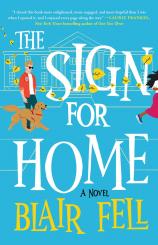The Sign for Home
Review
The Sign for Home
It's often through reading that we are exposed to people whose lifestyle, culture or religion is vastly different from ours. In THE SIGN FOR HOME, Blair Fell accomplishes this sometimes difficult task in a seemingly effortless manner by relating the story of Arlo Dilly, a DeafBlind young man who is a Jehovah's Witness and lives with his controlling uncle, Brother Birch. The novel is told from the points of view of Arlo and Cyril, an ASL interpreter who ends up working with Arlo, changing both their lives in the process.
Through this very expressive narrative, we learn --- to the extent that any seeing/hearing person can --- what it feels like to live unable to hear sounds or see the world around you. As a DeafBlind person, Arlo relies on others to help him cross the street safely, tell him when his ride has arrived, alert him to any danger, or even find a bathroom. We also are told about the many adaptive devices that DeafBlind people use to help them lead independent lives and communicate with those around them. Arlo doesn’t have many of these because his uncle prefers to keep him dependent.
"Reading THE SIGN FOR HOME will cause you to experience many emotions, from indignation to horror to heartbreak. Ultimately, though, this is a novel about the power of love --- not just romantic love but the love that evolves from friendship."
The two narratives are written so that we know instantly from which person we are "hearing." Arlo's is written in second person, and while I usually do not care for this perspective, it works quite well here. Cyril's is in first person. Fell shares their thoughts and feelings, and we are privy to their innermost secrets. It's impossible to convey the brilliance of the writing --- the emotion, the insight, the heartbreaking plot --- in a short review.
Arlo has his demons. When he attended a school for the deaf, he made friends and fell in love for the first time. Fell opens our eyes to how people without vision or hearing "see" the world around them. There are different types of signing, including Protactile, which helps to relay more information to a DeafBlind person than "simple" Tactile ASL, in which the individual must feel the hands of the interpreter to understand what is being expressed. The interpreters are required to translate everything without changing meaning or inserting their own thoughts or ideas.
Through Arlo and another character in the novel, we also are privy to the plight of many other-abled people --- how, in spite of the fact that they might live independently, those who are DeafBlind, paraplegic or deaf might be warehoused, unable to access their rights or live anything resembling a normal life. In Arlo's case, Brother Birch purposely keeps him dependent through lies, manipulation and religious threats. Cyril must decide how involved he should be in helping Arlo. It's quite a dilemma because technically he is limited to just translating, not opening Arlo's mind to possibilities.
Fell explains how a deaf child growing up in a household where the parents don't know ASL, and therefore can't teach him or her communication skills, is deprived of the ability to communicate and learn language. At one point, he shares that being fluent in ASL does not mean that the ASL "speaker" will be able to write fluently in English. Arlo's teacher at first can't believe that he is an intelligent person because of the quality of his writing, but he convinces her that he is both smart and articulate. These interactions open our eyes to the challenges people like Arlo face in making their wishes and ideas understood.
Reading THE SIGN FOR HOME will cause you to experience many emotions, from indignation to horror to heartbreak. Ultimately, though, this is a novel about the power of love --- not just romantic love but the love that evolves from friendship. It's a beautiful story that’s powerfully told.
Reviewed by Pamela Kramer on April 8, 2022




